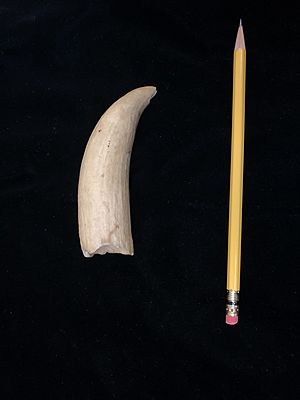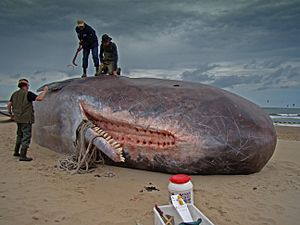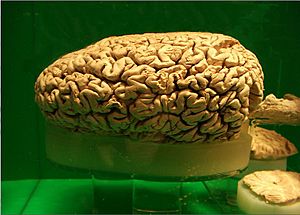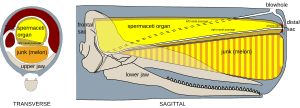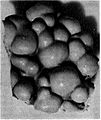Sperm whale facts for kids
Quick facts for kids Sperm whale |
|
|---|---|
 |
|
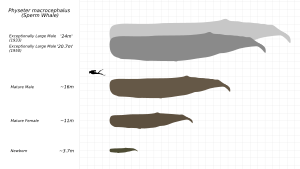 |
|
| Conservation status | |
| Scientific classification | |
| Genus: |
Physeter
|
| Species: |
macrocephalus
|
 |
|
| Major sperm whale grounds | |
| Synonyms | |
|
|
The sperm whale (Physeter catodon) is the biggest toothed whale in the world. It has the largest head of any animal on Earth! This huge head can be about 6 meters (20 feet) long, which is about one-third of the whale's entire body. Its lower jaw is quite small, but it holds giant, cone-shaped teeth. These teeth fit into special spaces in the upper jaw.
Contents
Amazing Biology of Sperm Whales
How Big Are Sperm Whales?
| Length | Weight | |
|---|---|---|
| Male | 16 metres (52 ft) | 41 tonnes (45 short tons) |
| Female | 11 metres (36 ft) | 14 tonnes (15 short tons) |
| Newborn | 4 metres (13 ft) | 1 tonne (1.1 short tons) |
Sperm whales are the largest toothed whales. Adult males can grow up to 20.7 meters (68 feet) long. They can weigh as much as 83 metric tons (about 183,000 pounds). To compare, the second largest toothed whale is much smaller.
Sperm whales are one of the most different-looking cetaceans (whales and dolphins) between males and females. When they are born, both male and female sperm whales are about the same size. But when they grow up, adult males are usually 30% to 50% longer. They can also be three times heavier than females.
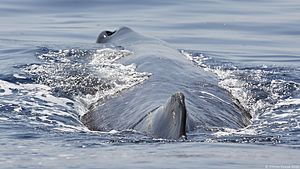
The sperm whale's body shape is very unique. You won't confuse it with any other whale. Its special shape comes from its very large, block-shaped head. This head can be a quarter to a third of the animal's total length. The blowhole, which is like a whale's nose, is shaped like an 'S'. It's located very close to the front of the head. It's also shifted to the whale's left side. This makes the whale's spray of water look bushy and angled forward.
The sperm whale's flukes (tail lobes) are triangular and very thick. They are bigger than those of any other cetacean. They are also very flexible. The whale lifts its flukes high out of the water. It does this when it starts a deep dive to find food. Instead of a dorsal fin on its back, it has a series of ridges. The largest ridge was called the 'hump' by old whalers. It can look like a dorsal fin because of its size and shape.
Most large whales have smooth skin. But the sperm whale's back skin is usually wrinkly. Some people who watch whales say it looks like a prune. Very rarely, albino sperm whales have been seen.
Sperm Whale Skeleton
The ribs of a sperm whale are connected to its spine by flexible cartilage. This allows the ribcage to flatten. This helps it handle the high pressure deep underwater. Even though sperm whales are great at diving, repeated deep dives can affect them over time. Their bones can show small holes. This is similar to "diving sickness" (decompression sickness) in humans. Older whale skeletons show more of this damage. Young whales, or calves, show no damage. This suggests that sudden trips to the surface could be dangerous for them.
Like all toothed whales, the sperm whale's skull is not perfectly even. This helps with echolocation, which is how they use sound to "see." Sound waves coming from different directions are processed differently. The openings for the nasal passages in the skull are tilted towards the left side.
Jaws and Teeth
The sperm whale's lower jaw is very narrow and sits underneath its upper jaw. It has 18 to 26 teeth on each side of its lower jaw. These teeth fit into special sockets in the upper jaw. The teeth are cone-shaped. Each tooth can weigh up to 1 kilogram (2.2 pounds). These teeth are useful, but they don't seem to be absolutely needed for catching or eating squid. Whales that were well-fed have been found without teeth or even with jaws that were not shaped correctly.
One idea is that the teeth are used when male whales fight each other. Adult males often have scars that look like they were made by teeth. There are also small, undeveloped teeth in the upper jaw. But these rarely come out into the mouth. Scientists can tell a whale's age by looking at its teeth. Just like the rings in a tree, the teeth grow in distinct layers.
The Sperm Whale Brain
The sperm whale's brain is the largest known brain of any animal, living or extinct. It weighs about 7.8 kilograms (17 pounds) on average. This is more than five times heavier than a human's brain. Its volume is about 8,000 cubic centimeters. While bigger brains often mean higher intelligence, it's not the only thing that matters. Elephants and dolphins also have bigger brains than humans.
The sperm whale's cerebrum (the main part of the brain) is the largest among all mammals. This is true both in its actual size and its size compared to the rest of the whale. The parts of its brain related to smell are small. This suggests that sperm whales don't have a very good sense of taste or smell. But the parts related to hearing are very large.
How Sperm Whales Breathe and Dive
The sperm whale's breathing system is made to handle big pressure changes when it dives. Its flexible ribcage allows its lungs to collapse. This reduces how much nitrogen it takes in. Its body can also slow down its energy use to save oxygen. After a dive, the sperm whale comes to the surface to breathe for about eight minutes. Then it dives again.
Toothed whales breathe air at the surface through a single blowhole. The sperm whale's blowhole is S-shaped and very much on the left side of its head. Sperm whales breathe out (spout) 3 to 5 times per minute when resting. This increases to 6 to 7 times per minute after a dive. The spout is a loud, single stream of water. It rises up to 2 meters (6.5 feet) or more above the surface. It points forward and to the left at a 45-degree angle.
Sperm whales have the longest digestive system in the world. It can be over 300 meters (984 feet) long in larger whales. Like animals that chew their cud, sperm whales have a four-chambered stomach. The first chamber has very thick, strong walls. It crushes food because whales can't chew. It also resists the claws and suckers of swallowed squid. The second chamber is larger, and this is where digestion happens. Undigested squid beaks build up in the second chamber. As many as 18,000 beaks have been found in some whales! Most squid beaks are vomited out by the whale. But some sometimes make it to the end of the gut. These beaks can help form ambergris.
The sperm whale's blood system is specially made for living in water. For example, the main artery leaving the heart gets wider. This helps keep blood flowing steadily even when the heart rate slows down during a dive. The blood has a lot of red blood cells. These cells carry oxygen using haemoglobin. When oxygen levels get low, the whale can send oxygen-rich blood only to its brain and other important organs.
Senses: Sound and Sight
Spermaceti Organ and Melon
On top of the whale's skull is a large group of organs. These are filled with a liquid mix of fats and waxes called spermaceti. These organs help the sperm whale make powerful, focused clicking sounds. The whale uses these sounds for echolocation (like sonar) and for talking to other whales.
The spermaceti organ is like a big barrel of spermaceti. Its outer wall, called the case, is very strong. The case can hold up to 1,900 liters (500 gallons) of spermaceti. This organ is bigger in male whales. The spermaceti inside is a mix of different fats and waxes. The amount of wax in the spermaceti organ increases as the whale gets older.
Below the spermaceti organ is the "junk." This part has sections of spermaceti separated by cartilage. It's similar to the melon found in other toothed whales. The junk's structure helps spread out physical stress across the skull. It might have developed to protect the head if the whale rams something.
Two air passages run through the whale's head. The left passage goes straight to the blowhole. The right passage goes under the spermaceti organ. It pushes air through a pair of "phonic lips" into a sac at the very front of the nose. When the whale is underwater, it can close its blowhole. Air that goes through the phonic lips can then go back to the lungs. Sperm whales have only one pair of phonic lips. Other toothed whales have two.
At the back of this spermaceti system is the frontal sac. Its back wall has fluid-filled bumps. These bumps reflect sound waves that come from the spermaceti organ. The spaces between the bumps trap a thin layer of air. This makes it a great sound mirror.
Some scientists think the spermaceti organs also help the whale control its buoyancy (how much it floats or sinks). They believe that before a dive, cold water enters the organ. The blood vessels might tighten, reducing blood flow and temperature. This would make the wax inside become solid and shrink. This change would make the whale heavier, helping it dive with less effort. When hunting, the whale's body heat might melt the spermaceti, making it more buoyant and easier to surface. However, newer research has found problems with this idea.
Herman Melville's famous story Moby-Dick suggests that the "case" holding the spermaceti acts like a battering ram. It might be used when males fight. There are also famous real-life stories. For example, the ships Essex and Ann Alexander were sunk by sperm whales. These whales were thought to weigh only one-fifth as much as the ships.
Eyes and Vision
The sperm whale's eye is similar to other toothed whales' eyes, but it's much bigger. It's the largest eye among toothed whales, weighing about 170 grams (6 ounces). It's shaped like an oval, flattened along the direction it sees. The cornea (front part of the eye) is oval, and the lens is round. The sclera (white part of the eye) is very hard and thick.
Like other toothed whales, sperm whales can pull their eyes back and push them forward. They have a thick muscle around the eye that helps them do this. However, they cannot roll their eyes in their sockets.
Scientists believe sperm whales have good vision and can see well in low light. They think sperm whales use their vision to hunt squid. They might spot squid by seeing their outlines from below. Or they might see the light that some deep-sea creatures make (bioluminescence).
Sleeping Habits
For a while, scientists have known that groups of sperm whales sometimes sleep for short times. They sleep in a vertical position, with their heads just below or at the surface. A study in 2008 showed that whales might sleep using both sides of their brain. It seems some whales can fall into a deep sleep for about 7% of the time. This usually happens between 6 p.m. and midnight.
What Do Sperm Whales Eat?
Sperm whales are carnivores, meaning they eat meat. They mostly hunt medium-sized squid. They also eat many kinds of fish, like skate. Sometimes they hunt giant squid that live on the ocean bottom in very deep waters. They can dive up to 2,250 meters (7,380 feet) deep. They can stay underwater for 1 hour. The largest male whales will sometimes even eat colossal squid.
How Sperm Whales Use Echolocation
Like other toothed whales, the sperm whale uses echolocation. This is a way of sensing things by making high-pitched clicking sounds. They then listen as these sounds bounce back off objects, like their prey. This is very important for hunting in the dark depths of the ocean.
Sperm Whale Conservation Status
We don't know the exact total number of sperm whales in the world. But it's thought to be in the hundreds of thousands. The future for sperm whales looks better than for many other whales. Commercial whaling (hunting whales for profit) has stopped. The species is now protected almost everywhere in the world. However, records show that Japan caught 51 sperm whales between 2000 and 2011.
Fishermen don't usually hunt the animals that sperm whales eat. But some long-line fishing boats in the Gulf of Alaska have complained. They say sperm whales sometimes steal fish from their lines.
Today, the biggest dangers to sperm whales are getting caught in fishing nets and crashing into ships. Other threats include eating marine debris (trash in the ocean), ocean noise, and chemical pollution. The International Union for the Conservation of Nature (IUCN) says the sperm whale is a "vulnerable" species. This means it could become endangered if threats continue. The species is also listed as endangered under the United States Endangered Species Act.
Images for kids
See also
 In Spanish: Cachalote para niños
In Spanish: Cachalote para niños





